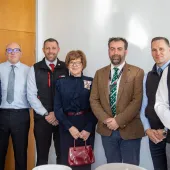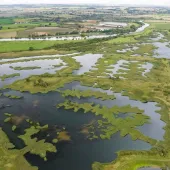Low-impact sustainable restoration at Ardley North Quarry

First published in the May 2014 issue of Quarry Management as Innovation in Action
Ardley North Quarry was operated by Smiths & Sons (Bletchington) Ltd from 2004 until limestone aggregate extraction ceased in 2010, under planning permissions granted by Oxfordshire County Council. The site’s original restoration proposals aimed to recreate low-level agricultural grassland. However, Smiths, in partnership with their landscape consultants ESP Ltd, believed that the restoration scheme had the potential to deliver a significantly wider range of environmental benefits.
In recognition of the site’s geological heritage, which includes two geological Sites of Special Scientific Interest (SSSI), the restoration objectives were altered to conserve and enhance these features, whilst proactively seeking to increase biodiversity. The Ardley Trackway’s SSSI is a layer of rock strata beneath the quarry floor, imprinted with dinosaur footprints, whilst the Ardley Cutting SSSI is a limestone exposure formed by the railway, located adjacent to the site. By working closely with Natural England, both SSSIs have been preserved for future generations to appreciate.
Following a site survey, it was recognized that surface water run-off rates were higher than anticipated, and that the approved attenuation scheme within the original restoration plan would be quickly inundated. Smiths and ESP used Pond Conservation’s (now the Freshwater Habitats Trust) ‘Aggregates Pond Creation Toolkit’ to design a new restoration scheme. This included a series of overflowing ponds which not only attenuate surface water and reduce erosion, but also enhance biodiversity. The ponds vary in profile from shallow gradated shorelines to rocky faces, and from permanent water to seasonally dry islands and shores. These features create a diversity of aquatic and marginal habitats for a range of potential species, including invertebrates, crustaceans (such as the white-clawed crayfish), wildfowl and waders.
Importantly, the ponds feed into a wider aquatic network through a specially created rock weir cut into the limestone ridge of the geological SSSI, with the permission of Natural England. This allows water to flow into the adjacent site’s pools, which are known to support colonies of great crested newts, allowing the development of new habitat linkages within the local area.
The brash side slopes of the quarry have been left to naturally regenerate and the upper parts of the quarry floor have been restored and seeded to unimproved pasture. A nearby badger’s sett has also been monitored and preserved during the restoration to prevent disturbance to foraging grounds.
The ponds, lowland meadow and lowland calcareous grassland recreated through the restoration of the quarry are all Oxfordshire Biodiversity Action Plan target habitats. This will mean that Oxfordshire has more of these valuable habitats thanks to the restoration of Ardley North, which was a cornerstone of gaining planning approval for the scheme.
The aftercare programme commenced in 2012 outlines the future land management of the site for wildlife conservation, mainly by using low-input agricultural practices. The aftercare plan identifies six potential habitat types: calcareous grassland; pond margin; pond water body; rock surface; spring-fed marsh; and unimproved pasture. Monitoring will be undertaken to encourage the geodiversity and biodiversity potential of this rare ‘off-line’ wetland site.
Natural England has recognized the value of the scheme by stating that: ‘…the additional enhancements for biodiversity that have been worked into the proposal are wholly welcomed and are above and beyond the agriculture element of the site in terms of potential biodiversity gain’.
Keith Hampshire, director of ESP and a Chartered Landscape Architect with 25 years’ experience in landscape and visual impact assessment and restoration in the minerals industry, said: ‘Ardley is a restoration scheme that could be a blueprint for the industry as a whole. The approach that Smiths & Sons have taken in engaging with the local authority and land owners has meant that they have been able to reduce their aftercare liabilities, whilst still providing a rare and ecologically valuable habitat to the county of Oxfordshire.’
In recognition of the novel and inclusive approach the partners had shown in the restoration of Ardley North Quarry, the Minerals Products Association (MPA) announced the site as the winner of the Innovation category in the MPA Biodiversity Awards 2013.
The work that Smiths & Sons (Bletchington) and ESP have undertaken restoring hard rock quarries in a low-input but ecologically sensitive fashion provides a novel and inspiring opportunity for the minerals industry to consider.
- Subscribe to Quarry Management, the monthly journal for the mineral products industry, to read articles before they appear on Agg-Net








